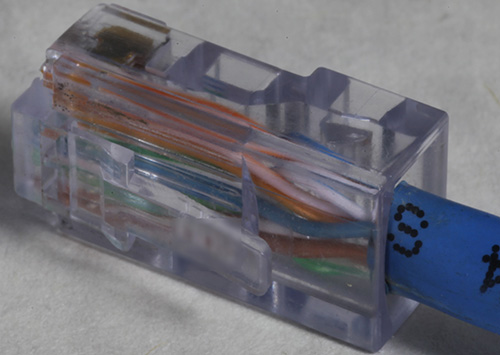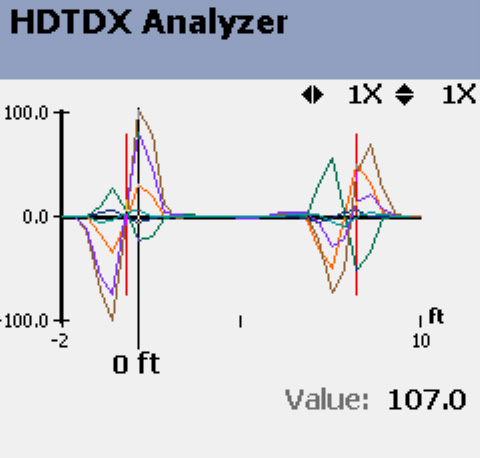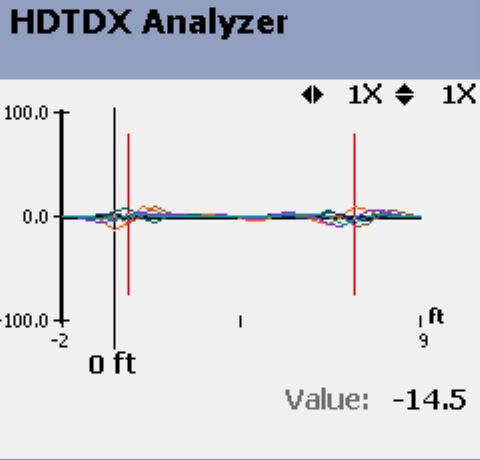Terrible Terminations
There are at least two good ways to make a bad Ethernet cable. One can start with badly-made bulk cable -- this seems to be the usual explanation for Chinese-made Ethernet cables -- or one can take good cable and do a terrible job of putting connectors on it. Some types of connectors -- a crimp BNC, for example -- are very easy to put onto a cable if someone has shown you how and you've got the right tools for the job, but the 8-pin Ethernet connector is another matter entirely. Bad technique, applied to perfectly good cable and connectors, can give you an apparently good connection, but horrible loss characteristics.
A Customer, A Problem:
Last week (this article was written February 2015) a customer wrote to us with a problem. He's dealing with network performance issues at a small company, and has come to suspect that bad patch cords, made by an electrician, account for some of the problems he's seeing. He asked if we would be willing to test one of his patch cords to see how it performed, and we were happy to oblige.
The Cable Under Test:
The patch cord arrived in the mail. It was about 7 feet long, bore branding from a major company dealing in industrial electronics, had a "Cat 6" designation on the jacket, and was terminated with fairly typical field-installable connectors. We plugged it in to our Fluke DTX tester, dialed up the 2.5 metre patch cord test limits, and tested it to ISO Cat 6 standards. The test came back absolutely awful, failing the Cat 6 crosstalk limits by over 10 dB. Stepping the protocol down to Cat 5e, we tested it again, and it still failed, though by a more modest 1.6 dB. Here are the test reports.
Now, at this point there are really only two possible causes, and this quite spectacular failure could be the product of one or both of them. First, there is the possibility that the bulk cable from which this patch cord was made is no good. Second, there is the possibility that the connectors are causing the problem, either because they're not very well designed or because they've been badly applied to the cable.
A Picture Worth a Thousand Mbps:
A quick look at the connectors confirmed that all was not right. This cable was put together using a pass-through type plug, where the eight conductors are lined up in order, threaded through the plug, and then cut off after crimping. These plugs are not the best performers electrically, but it is possible to get good results with them, so the plug was not likely to be the cause of such a large-scale failure. Looking through the plastic at the wires, however, it became clear that not a lot of care had gone into termination. There's a lot that could be said, and more than one thing wrong here, but one picture in particular illustrates the sort of thing we saw:

Note the blue wire, and its blue/white companion. This was a 568B termination, which means that these two wires are headed for adjacent pins (4 and 5) on the connector. Note that the blue goes off to the left, while the blue/white goes off to the right -- the blue-white is basically wrapped right around the orange pair, which sits between it and its mate.
Other things are not well in these connectors. Conductors are sharply bent, probably due to some awkward shoving-in to the connector body. Pairs are inartfully routed to their destinations, resulting in their being squished hard into other pairs. And then, in a move that neither helped crosstalk nor mechanical stability, one of the connectors was crimped on downstream of the end of the cable jacket -- so instead of gripping jacket, the back-crimp of the connector was smashing pairs into pairs without any cushioning or ability to slip around in-jacket.
What Does the Fluke Say?
Clearly, the termination was a huge part of the issue here. The Fluke tester confirmed as much, in its diagnostic screen, the "HDTDX" display, which shows a time-domain representation of the crosstalk characteristics of the cable. An ideal HDTDX result -- not attainable -- would be a completely flat line from the area around the left vertical red line (representing the first connector) to the area around the right vertical red line (representing the second connector). Here, there are instead two immense bumps (well, six on each end; the graph shows all six possible pair-to-pair combinations) at these locations, and what this means is that crosstalk at these points is a problem. The relative flatness of the lines between suggests, additionally, that the cable itself, disregarding the connectors, is probably just fine.

Let's Try This Again:
The easiest way, ultimately, to figure out whether bad termination is the sole cause of the problem is simply to do a good retermination. We cut the connectors off and reterminated the cable. Upon cutting the connectors off, we found what looked like a fairly typical Cat 6 cable profile: there was an X-spline down the middle to separate the four pairs, and the four pairs were nicely arranged, with orange and brown opposite one another, so that whichever end of the cable one is working from, the pairs can be lined up in order (for 568B) without having to cross any of them over the others. We used our standard plug, and got a proper crimp on it, and put it back on the Fluke tester.
Success! The original termination had failed the Cat 6 crosstalk test by 10.8 dB, and our retermination passed the test by 4.5 dB -- a 15.3 dB improvement. Simply using a good connector and following good practices turned a spectacular fail into a comfortable pass. This test result certainly vindicates the bulk cable, which plainly was of good quality. Here, if you'd like to see them, are the post-retermination test reports.
Now, let's go back to that HDTDX chart. Here's what it looks like after retermination:

As you can see, there are still bumps at the connectors -- that's normal, and there's no way to affix standard 8-pin Ethernet connectors to cable without seeing this result -- but the magnitude of the bumps is a fraction of what it was when we received this cable.
So, What's The Lesson?
Most of us, if we do not deal in high-speed digital signalling, have a kind of "DC Circuits" understanding of wiring where the most important thing is simply that the wires connect the right points together. One can even be a career electrician and be trapped in that kind of thinking, because in residential power wiring, things are pretty much either hooked up correctly or not; nobody's oven fails because somebody untwisted too much power cord. It is, therefore, easy to assume that if you've got Ethernet cables to make, and you can reliably connect pin 1 to pin 1, pin 2 to pin 2, and so on, all will be well. Many electricians are skilled at assembling data cables -- heck, all of our installed horizontal cabling (in-wall and in-tray cable to jacks, that is) here at BJC headquarters was installed by our electrician, and his work tested out perfectly. But it's a mistake to assume that just because network signals are electrical, any electrician is automatically qualified to put a network together.
If all you need is Cat 5e performance -- and that's often the case -- it isn't hard to make good patch cords. You need good cable, good connectors, and good technique. The internet abounds with tutorials on this stuff. For good cable, consider buying American -- there are a number of data cable manufacturers who are keeping jobs in the USA, whose products are reasonably priced, and whose products really do what they say. Our experience has been that Chinese data cable is almost always terrible, sometimes to an astonishing degree -- and that includes Chinese cable from Internet vendors who are widely trusted. For good connectors, likewise there are excellent choices, including some American manufacturers (we use mostly Sentinel).
But as this example shows, you can start with good cable and make bad assemblies -- in fact, you can start with excellent cable and make horrible assemblies. Keep these things in mind:
(1) the length of wire to be untwisted should be only the amount you need to be able to insert into the connector; any additional untwisting will only harm performance.
(2) when you're arranging wires, don't fight the cable if you don't have to. In this case, the wires came out of the cable end in a very nice configuration, amenable to simple, straight routing into the connector, and the user turned it into a mess.
(3) make sure that your total stripped-jacket length is short enough to make the back crimp on the connector fall on JACKET, not on bare pairs.
If you've got good materials and good technique, your Cat 5e cables will be Cat 5e compliant the vast majority of the time. If you're looking for Cat 6 compliance, it's possible to do but you're likely to need to be much more picky about cable and connectors, and significantly fussier about termination techniques, and probably will not be able to do it consistently unless you have a proper tester to give you feedback on your work. Cat 6a is another matter entirely -- meeting crosstalk standards between 250 and 500 MHz is quite a challenge, and it's possible to have compliant cable, compliant connectors, good technique and no success, as the right solution turns out to be a sort of synergistic product of all three.


